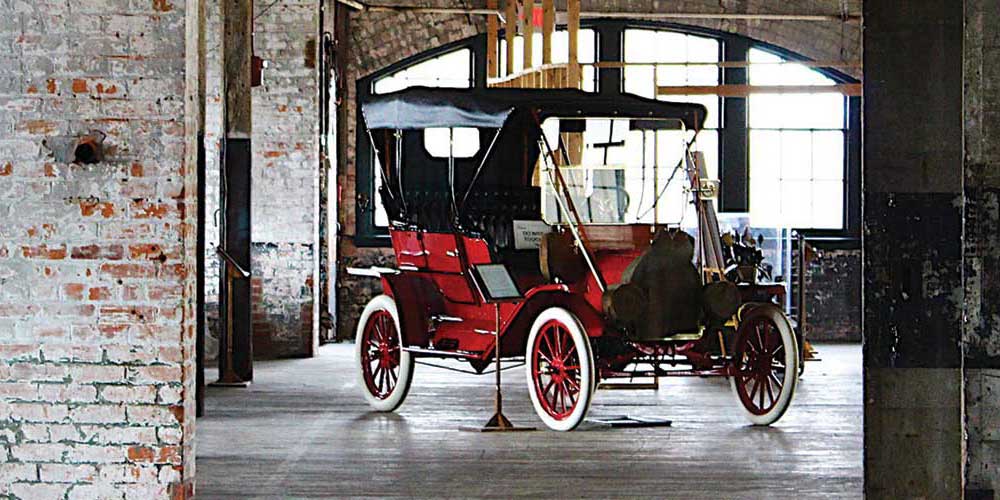By Robert Tate, Automotive Historian and Researcher
Images courtesy of the National Automotive History Collection
Posted: 10.09.2017
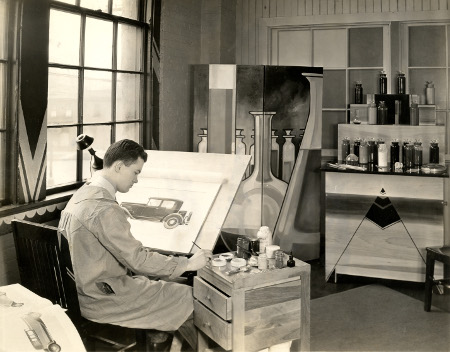 Early 1930s StylingThe early days of automotive design studios were very different from design studios today. Even from the formative days, however, automakers understood the importance of design.
Early 1930s StylingThe early days of automotive design studios were very different from design studios today. Even from the formative days, however, automakers understood the importance of design.
It was the late Andrew F. Johnson, who had spent the better part of his great career from 1892 to 1943 teaching carriage and automobile design at the beginning of the 20th century. Early pioneers such as Johnson helped write the history of the design studio and its critically important role in our automotive heritage.
In their book, “A Century of Automotive Style: 100 Years of American Car Design,” Michael Lamm and Dave Holls crystalize the importance of design in automotive: “Consider further, over the span of those same 100 years, how many times the individual sale of each automobile must have been prompted by the way it looked: its first impression in the showroom.”
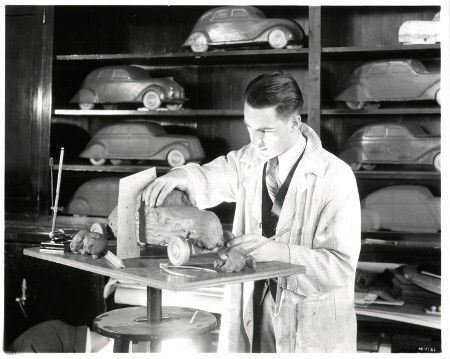 Chrysler modler styling 1930s carsMany famous artists and illustrators have been part of this great heritage over the years. In 1927, General Motors introduced styling to the automobile industry and set in motion a new way for consumers to look at an automobile as part of the sales process. By the mid 1920s, cars began to lose some of their individuality as engineering progress narrowed the difference between competitive makes.
Chrysler modler styling 1930s carsMany famous artists and illustrators have been part of this great heritage over the years. In 1927, General Motors introduced styling to the automobile industry and set in motion a new way for consumers to look at an automobile as part of the sales process. By the mid 1920s, cars began to lose some of their individuality as engineering progress narrowed the difference between competitive makes.
Around that time a great stylist and custom automobile builder by the name of Harley J. Earl was commissioned General Motors -- under the leadership of another automotive pioneer, Alfred P. Sloan -- to design a great looking vehicle for the Cadillac Motor Car Division. The car was the popular La Salle model, which became one of the U.S. auto industry's first design exercises in product planning.
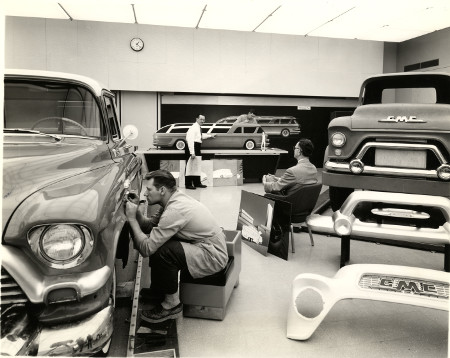 GMC Styling Studio 1956-1957The car was an instant success when it was introduced. It created a new way of how consumers admired and looked at new automobiles. One of the most important moments in our automotive history was when General Motors established the Art and Colour studio. By January, 1928, Earl had assembled 50 employees in his Art and Colour Section, which marked the first time that a large corporation had seriously considered styling as an integral part of its sales program. By the late 1930s, Harley Earl had built up great styling credentials within GM which led to great successes under his stewardship.
GMC Styling Studio 1956-1957The car was an instant success when it was introduced. It created a new way of how consumers admired and looked at new automobiles. One of the most important moments in our automotive history was when General Motors established the Art and Colour studio. By January, 1928, Earl had assembled 50 employees in his Art and Colour Section, which marked the first time that a large corporation had seriously considered styling as an integral part of its sales program. By the late 1930s, Harley Earl had built up great styling credentials within GM which led to great successes under his stewardship.
Another great name part of our American automotive styling culture is the late Gordon Buehrig. Buehrig is best known for his development of the elegant Cord automobiles. This great automotive visionary worked under Auburn-Cord-Duesenberg, the Budd Company, the Raymond Loewy Design Studio at Studebaker and the Ford Motor Company.
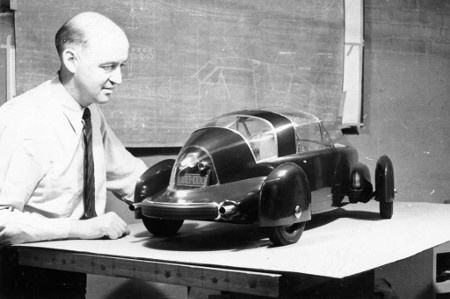 Tasco-prototype by Gordon-BuehrigOne of the images that is a part of this story represents Gordon Buehrig's, Tasco prototype car/plane design that was completed in 1948. Buehrig at the time said this about the model, “You might say, it was my personal Edsel. It was not a very significant automobile in the broad scope of history, and since only one prototype was built, it would seem that after a quarter century the car would be forgotten. But it still exists to haunt me.”
Tasco-prototype by Gordon-BuehrigOne of the images that is a part of this story represents Gordon Buehrig's, Tasco prototype car/plane design that was completed in 1948. Buehrig at the time said this about the model, “You might say, it was my personal Edsel. It was not a very significant automobile in the broad scope of history, and since only one prototype was built, it would seem that after a quarter century the car would be forgotten. But it still exists to haunt me.”
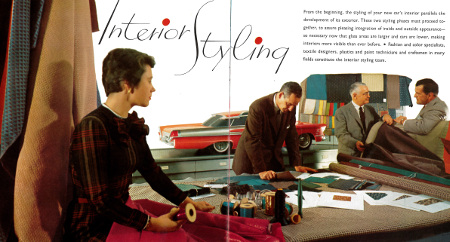 Ford Stlying Studio 1956-1957Henry Ford’s only child and a visionary in his own right, Edsel Ford, would be the first name associated with styling at Ford Motor Co. As a teenager, Edsel loved to draw automobiles. He kept several scrapbooks showing all the popular European salon models.
Ford Stlying Studio 1956-1957Henry Ford’s only child and a visionary in his own right, Edsel Ford, would be the first name associated with styling at Ford Motor Co. As a teenager, Edsel loved to draw automobiles. He kept several scrapbooks showing all the popular European salon models.
In 1935, Edsel Ford called Bob Gregorie to ask if he would like to set up a design department that could utilize both Lincoln and Ford styling models. General Motors and Chrysler by that time had already established their own design departments with Chrysler hiring the well-known Ray Dietrich in 1932.
Gregorie directed Ford's styling from 1935 through World War II. Gregorie started his career in 1927 as a yacht designer for the Electric Boat Company. He also had spent many years as a naval architect.
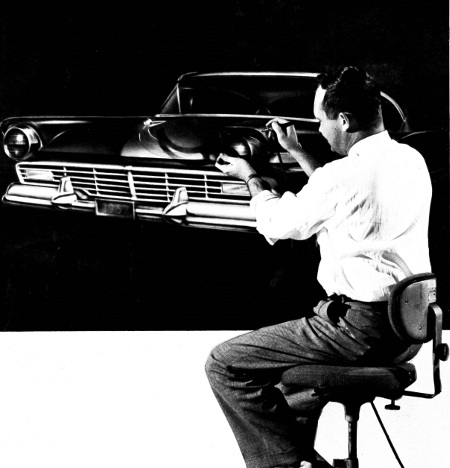 Designing 1957 FordGregorie first joined Ford Motor Company in 1931 as a body designer assigned to Lincoln’s engineering department. Just four years later, Gregorie established the Ford styling group which started Ford's styling history and culture in America. Another famous name behind Ford design legacy is George W. Walker who was named the first vice president of Ford styling in 1955.
Designing 1957 FordGregorie first joined Ford Motor Company in 1931 as a body designer assigned to Lincoln’s engineering department. Just four years later, Gregorie established the Ford styling group which started Ford's styling history and culture in America. Another famous name behind Ford design legacy is George W. Walker who was named the first vice president of Ford styling in 1955.
Not shown in this article are the post-war designs of the 1947 Studebaker which was one of the most innovative designs of all times.
In conclusion, the early days of automotive styling will always be a part of our great automotive history and culture.
For further information on photos please visit http://www.detroitpubliclibrary.org/ or email This email address is being protected from spambots. You need JavaScript enabled to view it.. Please do not republish the story and/or photographs without permission of MotorCities National Heritage Area.
Bibliography:
Holls Dave & Lamm Michael. “A Century of Automotive Style 100 years of American car design” 1996.
Bayley Stephen. “Harley Earl and the Dream Machine” 1983.
Buehrig M. Gordon & Jackson S. William. “Rolling Sculpture A designer and his work” 1975
Introduction to styling. Ford Motor Company 1956/57.
If you would like to contribute an article for the MotorCities newsletter, email This email address is being protected from spambots. You need JavaScript enabled to view it. or call 313-259-3425.

